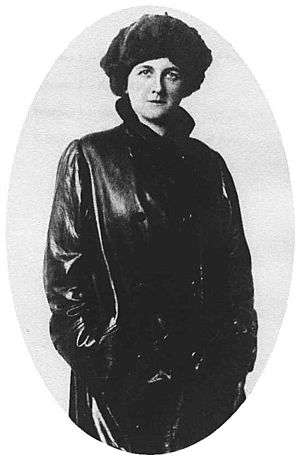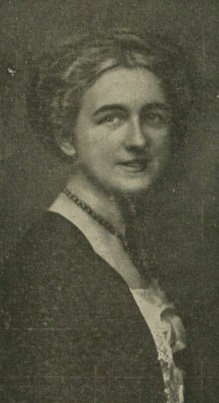Maria Czaplicka facts for kids
Quick facts for kids
Maria Antonina Czaplicka
|
|
|---|---|

Czaplicka in 1916
|
|
| Born | 25 October 1884 |
| Died | 27 May 1921 (aged 36) Bristol, England, United Kingdom
|
| Occupation | Anthropologist |
Maria Antonina Czaplicka (born October 25, 1884 – died May 27, 1921) was a Polish cultural anthropologist. This means she was a scientist who studied human cultures and societies. She is famous for her research on Siberian shamanism, which is a spiritual practice found in Siberia.
Czaplicka's work can be found in three main books: Aboriginal Siberia (1914), a travel book called My Siberian Year (1916), and a collection of talks titled The Turks of Central Asia (1918). All three books, plus a fourth book of her articles and letters, were re-released in 1999.
Contents
Early Life and Education
Maria Czaplicka was born in 1884 in Warsaw, Poland. Her family used to be noble but had lost their wealth. Her parents, Zofia and Feliks Czaplicki, moved to the city for work because of political problems in Poland. Maria was the third of five children.
Her father found a job in what is now Latvia, and the family lived there from 1904 to 1906. This time allowed Maria to take an important exam. This exam later helped her get into university.
She went to the Anna Jasieńska Girls' School until 1902. For her higher education, she attended the Flying University. This was a secret, underground school in Russian-controlled Poland. Maria worked many jobs to support herself. She was a teacher, a secretary, and a companion for a lady.
She also gave talks at the University for Everyone and the Society of Polish Culture. Maria even wrote poetry, which was published in a Warsaw magazine called Odrodzenie. While recovering from an illness, she wrote a children's novel called Olek Niedziela. In 1910, she received a special scholarship called the Mianowski Scholarship. This allowed her to continue her studies in the United Kingdom.
Maria left Poland in 1910. In 1911, she had an operation in London. She then continued her studies at the London School of Economics and Somerville College, Oxford. She studied anthropology, which is the study of human societies and cultures. Her professor, R.R. Marett, encouraged her to use her Russian language skills. He suggested she review books about the native tribes in Siberia. This research became her book Aboriginal Siberia, published in 1914.
In 1914, she joined the Royal Anthropological Society. This is a group for people who study human cultures. She also presented research on how religion and the environment are connected in Siberia. Even though she had never been to Siberia, her book was so good that it became a very important reference work in its field.
The Yenisei Expedition
Maria Czaplicka's book about Siberia was meant to prepare her for real research there. In May 1914, she started her fieldwork. She received money from the Mary Ewart Travelling Scholarship. She led a team from University of Oxford and the University of Pennsylvania Museum of Archaeology and Anthropology.
Her team included an English bird expert named Maud Doria Haviland, an English painter named Dora Curtis, and Henry Usher Hall from the Museum. They arrived in Russia just before World War I began. When the war started, Czaplicka and Hall decided to continue their journey. The others went back to the United Kingdom.
Czaplicka and Hall, along with a Tungus woman named Michikha, spent the whole winter traveling. They journeyed along the Yenisei River for more than 3,000 kilometers (about 1,860 miles).
Maria Czaplicka took hundreds of photos of Siberian people. She also made many notes about their body measurements and customs. She collected 193 objects for the Pitt Rivers Museum in Oxford. She also gathered plant samples for the Fielding-Druce Herbarium. It is thought that she made recordings of the languages they heard, but these recordings are not well known. The expedition faced many financial and political challenges, which made their overall results modest.
Czaplicka was also known for disagreeing with the term "Arctic Hysteria." This term was used by Western researchers to describe certain nervous conditions. She believed in cultural relativism. This means that you should try to understand a culture from its own point of view, not judge it based on your own culture. She explained that what Western academics called "hysteria" was seen very differently in Siberian cultures. This was part of her studies on Shamanism in Siberia.
Later Life and Achievements
Czaplicka returned to England in 1915. She wrote a diary about her trip called My Siberian Year, which became very popular when it was published in 1916. In the same year, she became the first female lecturer in anthropology at Oxford University. She gave talks about countries in Central and Eastern Europe, as well as about Siberian tribes. She also spoke about Polish issues.
In 1920, she received the Murchison Award from the Royal Geographical Society. This award was for her important work in Northern Siberia. Even with this award, her financial situation was not stable. Her three-year teaching position at Oxford ended in 1919. She then got a temporary teaching job at the University of Bristol.
In 1921, she did not get a special travel fellowship she had hoped for. She died in May of that year. The University of Bristol expressed sadness at losing such a talented member of their staff. Czaplicka is buried in the Wolvercote Cemetery in Oxford.
Legacy and Impact
Months before she died, Maria Czaplicka left her notes and reports to her colleague, Henry Usher Hall. After Hall passed away in 1944, some of Czaplicka's early papers were given to the University of Pennsylvania Museum. Her main papers are kept at Somerville College, Oxford. Polish museums also have some of her private letters.
In 1971, Barbara Aitkin, a friend of Czaplicka's, created a fund at Somerville College to honor her memory. In 2015, the Pitt Rivers Museum in Oxford held a small exhibit. It was called "My Siberian Year, 1914–1915" and celebrated 100 years since Czaplicka's expedition to Siberia.
Selected Works
- Shamanism in Siberia. Oxford at the Clarendon Press, 1914.
- "The Life and Work of N.N. Miklubo-Macklay". Man. 14. pp. 198–203, 1914.
- My Siberian Year. London, Mills and Boon, 1916.
- "Tribes of the Yenisei. The Oxford Expedition". Times Russian Supplement. 13. p. 6. 18 September 1915.
- "The Evolution of the Cossack Communities". Journal of the Central Asian Society. 5. pp. 42–58. 1918.
- "A plea for Siberia". New European. 6. pp. 339–344. 1918.
- The Turks of Central Asia in History and at the Present Day, An Ethnological Inquiry into the Pan-Turanian Problem, and Bibliographical Material Relating to the Early Turks and the Present Turks of Central Asia. Oxford: Clarendon Press. 1918.
- "Poland". The Geographical Journal. 53:36. 1919.
- "History and Ethnology in Central Asia". Man. 21. pp. 19–24. 1921.
See also
- List of Poles


